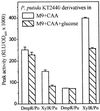Integration of global regulation of two aromatic-responsive sigma(54)-dependent systems: a common phenotype by different mechanisms
- PMID: 11790746
- PMCID: PMC139538
- DOI: 10.1128/JB.184.3.760-770.2002
Integration of global regulation of two aromatic-responsive sigma(54)-dependent systems: a common phenotype by different mechanisms
Abstract
Pseudomonas-derived regulators DmpR and XylR are structurally and mechanistically related sigma(54)-dependent activators that control transcription of genes involved in catabolism of aromatic compounds. The binding of distinct sets of aromatic effectors to these regulatory proteins results in release of a repressive interdomain interaction and consequently allows the activators to promote transcription from their cognate target promoters. The DmpR-controlled Po promoter region and the XylR-controlled Pu promoter region are also similar, although homology is limited to three discrete DNA signatures for binding sigma(54) RNA polymerase, the integration host factor, and the regulator. These common properties allow cross-regulation of Pu and Po by DmpR and XylR in response to appropriate aromatic effectors. In vivo, transcription of both the DmpR/Po and XylR/Pu regulatory circuits is subject to dominant global regulation, which results in repression of transcription during growth in rich media. Here, we comparatively assess the contribution of (p)ppGpp, the FtsH protease, and a component of an alternative phosphoenolpyruvate-sugar phosphotransferase system, which have been independently implicated in mediating this level of regulation. Further, by exploiting the cross-regulatory abilities of these two circuits, we identify the target component(s) that are intercepted in each case. The results show that (i) contrary to previous speculation, FtsH is not universally required for transcription of sigma(54)-dependent systems; (ii) the two factors found to impact the XylR/Pu regulatory circuit do not intercept the DmpR/Po circuit; and (iii) (p)ppGpp impacts the DmpR/Po system to a greater extent than the XylR/Pu system in both the native Pseudomonas putida and a heterologous Escherichia coli host. The data demonstrate that, despite the similarities of the specific regulatory circuits, the host global regulatory network latches onto and dominates over these specific circuits by exploiting their different properties. The mechanistic implications of how each of the host factors exerts its action are discussed.
Figures






Similar articles
-
The alarmone (p)ppGpp mediates physiological-responsive control at the sigma 54-dependent Po promoter.Mol Microbiol. 1999 Feb;31(4):1217-28. doi: 10.1046/j.1365-2958.1999.01264.x. Mol Microbiol. 1999. PMID: 10096088
-
Growth phase-dependent transcription of the sigma(54)-dependent Po promoter controlling the Pseudomonas-derived (methyl)phenol dmp operon of pVI150.J Bacteriol. 1996 Jul;178(13):3727-35. doi: 10.1128/jb.178.13.3727-3735.1996. J Bacteriol. 1996. PMID: 8682773 Free PMC article.
-
Cross-regulation by XylR and DmpR activators of Pseudomonas putida suggests that transcriptional control of biodegradative operons evolves independently of catabolic genes.J Bacteriol. 1994 Aug;176(16):5052-8. doi: 10.1128/jb.176.16.5052-5058.1994. J Bacteriol. 1994. PMID: 8051017 Free PMC article.
-
Transcriptional control of the Pseudomonas TOL plasmid catabolic operons is achieved through an interplay of host factors and plasmid-encoded regulators.Annu Rev Microbiol. 1997;51:341-73. doi: 10.1146/annurev.micro.51.1.341. Annu Rev Microbiol. 1997. PMID: 9343354 Review.
-
ppGpp: a global regulator in Escherichia coli.Trends Microbiol. 2005 May;13(5):236-42. doi: 10.1016/j.tim.2005.03.008. Trends Microbiol. 2005. PMID: 15866041 Review.
Cited by
-
Cell density-dependent gene contributes to efficient seed colonization by Pseudomonas putida KT2440.Appl Environ Microbiol. 2004 Sep;70(9):5190-8. doi: 10.1128/AEM.70.9.5190-5198.2004. Appl Environ Microbiol. 2004. PMID: 15345399 Free PMC article.
-
Integration of signals through Crc and PtsN in catabolite repression of Pseudomonas putida TOL plasmid pWW0.Appl Environ Microbiol. 2005 Aug;71(8):4191-8. doi: 10.1128/AEM.71.8.4191-4198.2005. Appl Environ Microbiol. 2005. PMID: 16085802 Free PMC article.
-
FtsH-dependent degradation of phage shock protein C in Yersinia enterocolitica and Escherichia coli.J Bacteriol. 2011 Dec;193(23):6436-42. doi: 10.1128/JB.05942-11. Epub 2011 Sep 30. J Bacteriol. 2011. PMID: 21965563 Free PMC article.
-
Transcription from bacteriophage lambda pR promoter is regulated independently and antagonistically by DksA and ppGpp.Nucleic Acids Res. 2009 Nov;37(20):6655-64. doi: 10.1093/nar/gkp676. Epub 2009 Sep 16. Nucleic Acids Res. 2009. PMID: 19759216 Free PMC article.
-
Medium-chain-length polyhydroxyalkanoates synthesis by Pseudomonas putida KT2440 relA/spoT mutant: bioprocess characterization and transcriptome analysis.AMB Express. 2017 Dec;7(1):92. doi: 10.1186/s13568-017-0396-z. Epub 2017 May 12. AMB Express. 2017. PMID: 28497290 Free PMC article.
References
-
- Abril, M. A., M. Buck, and J. L. Ramos. 1991. Activation of the Pseudomonas TOL plasmid upper pathway operon. Identification of binding sites for the positive regulator XylR and for integration host factor protein. J. Biol. Chem. 266:15832–15838. - PubMed
-
- Aviv, M., H. Giladi, G. Schreiber, A. B. Oppenheim, and G. Glaser. 1994. Expression of the genes coding for the Escherichia coli integration host factor are controlled by growth phase. rpoS, ppGpp and by autoregulation. Mol. Microbiol. 14:1021–1031. - PubMed
-
- Blaszczak, A., C. Georgopoulos, and K. Liberek. 1999. On the mechanism of FtsH-dependent degradation of the ς32 transcriptional regulator of Escherichia coli and the role of the DnaK chaperone machine. Mol. Microbiol. 31:157–166. - PubMed
-
- Bochner, B. R., and B. N. Ames. 1982. Complete analysis of cellular nucleotides by two-dimensional thin layer chromatography. J. Biol. Chem. 257:9759–9769. - PubMed
MeSH terms
Substances
LinkOut - more resources
Full Text Sources
Other Literature Sources

